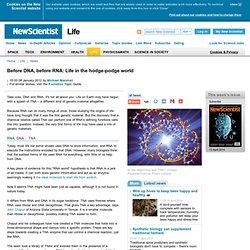

First life: The search for the first replicator - life - 15 August 2011. Read full article Continue reading page |1|2|3 Life must have begun with a simple molecule that could reproduce itself – and now we think we know how to make one 4 BILLION years before present: the surface of a newly formed planet around a medium-sized star is beginning to cool down.

It's a violent place, bombarded by meteorites and riven by volcanic eruptions, with an atmosphere full of toxic gases. But almost as soon as water begins to form pools and oceans on its surface, something extraordinary happens. This was the dawn of evolution. Billions of years later, some of the descendants of those first cells evolved into organisms intelligent enough to wonder what their very earliest ancestor was like. As far back as the 1960s, a few of those intelligent organisms began to suspect that the first self-replicating molecules were made of RNA, a close cousin of DNA. When biologists first started to ponder how life arose, the question seemed baffling. After that the floodgates opened. Before DNA, before RNA: Life in the hodge-podge world - life - 08 January 2012. Take note, DNA and RNA: it's not all about you.

Life on Earth may have begun with a splash of TNA – a different kind of genetic material altogether. Because RNA can do many things at once, those studying the origins of life have long thought that it was the first genetic material. But the discovery that a chemical relative called TNA can perform one of RNA's defining functions calls this into question. Instead, the very first forms of life may have used a mix of genetic materials.
Today, most life bar some viruses uses DNA to store information, and RNA to execute the instructions encoded by that DNA. A key piece of evidence for this "RNA world" hypothesis is that RNA is a jack of all trades. Now it seems TNA might have been just as capable, although it is not found in nature today. It differs from RNA and DNA in its sugar backbone: TNA uses threose where RNA uses ribose and DNA deoxyribose. First life: The search for the first replicator - life - 15 August 2011. Read full article Continue reading page |1|2|3 Life must have begun with a simple molecule that could reproduce itself – and now we think we know how to make one 4 BILLION years before present: the surface of a newly formed planet around a medium-sized star is beginning to cool down.

It's a violent place, bombarded by meteorites and riven by volcanic eruptions, with an atmosphere full of toxic gases. But almost as soon as water begins to form pools and oceans on its surface, something extraordinary happens. This was the dawn of evolution. Billions of years later, some of the descendants of those first cells evolved into organisms intelligent enough to wonder what their very earliest ancestor was like. As far back as the 1960s, a few of those intelligent organisms began to suspect that the first self-replicating molecules were made of RNA, a close cousin of DNA.
When biologists first started to ponder how life arose, the question seemed baffling. After that the floodgates opened. Primordial Pac-Man: Oil droplet hints at life's origin - life - 02 March 2011. Simple oil drops show that if you get the conditions right, basic life may emerge almost fully formed WHEN Stanley Miller and Harold Urey created amino acids by shooting sparks through a "primordial atmosphere" of methane, ammonia, hydrogen and water, biologists thought a full understanding of the origins of life was within reach.

Almost 60 years on from the most famous origin-of-life experiment of them all, we're still waiting. Could that be because biologists have been looking at the wrong part of the experiment? A fresh look at the tarry residue left behind in a Miller-Urey-style experiment has revealed something remarkable: when injected into a simple oil droplet, the gunk endows it with spookily lifelike behaviour - although crucially it cannot yet reproduce. Like Pac-Man, an oil droplet doped with tarry junk can sense and respond to its neighbours and move towards "food" sources. ... Forget antibiotics, try nanoparticles instead - health - 03 December 2011. FORGET antibiotics, let's try nanoparticles.

That's according to DARPA, the US military's research arm, which says that rather than spend money on new antibiotics, which only work until bacterial strains grow resistant, "readily adaptable nanotherapeutics" can fight infection instead. The agency has called for proposals to find ways to use small interfering RNA (siRNA) to fight bacteria. These scraps of genetic code seek out their mirror image within cells, such as bacteria, and silence them. This stops protein production and leads to cell death. DARPA is seeking ideas for adaptable nanoparticles that can be "reprogrammed on the fly" by loading up specific siRNA to deal with outbreaks among troops.
As with GPS systems and the internet, this innovation might benefit the military initially, but eventually become a model for mainstream medication. New Scientist Not just a website! More From New Scientist When does multiverse speculation cross into fantasy? More from the web.